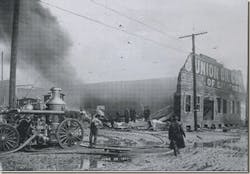BROOKLYN, NY: JUNE 3, 1911 - Two separate fires occurred in the Florence House, a summer hotel on Bay 17th Street in the Bath Beach section. As firemen battled the first fire on the ground floor, a team of horses attached to a hose wagon bolted from the scene and ran away. Busy firemen did not miss the rig or the horses until a short while later, when a police officer led them back to the scene after he stopped the runaways several blocks away. Later that afternoon, another fire was extinguished in a second-floor bedroom. This was the third fire to occur within the month. The hotel was due to open in two weeks. Fire marshals were investigating the fires.
BRONX, NY: JUNE 5, 1911 - One of the first people to escape the blazing Powers Co. plant, manufacturers of moving picture film, was Al Leach, the company's cameraman. Sixty actors and crew were busy filming “The Vampire” on the first floor of the wood-frame building when an explosion and fire on the second floor sent them running. With a few hundred feet of film left in his camera, Leach found a clear vantage point and filmed the rapidly extending flames and the three-alarm response of the fire department. Explosion after explosion sent waves of flames across the street, igniting the wooden homes. The fire was battled into the afternoon. The original fire building and a number of homes were destroyed.
ITHACA, NY: JUNE 10, 1911 - Flames broke out on a lower floor of the Sigma Alpha Epsilon fraternity house on the campus of Cornell University. Before the city firemen could ascend to the campus, flames swept up through an elevator shaft and fully engulfed the doomed structure. The house sat on a bluff overlooking Cayuga Lake and the city and as the house burned furiously, firemen struggled to prevent embers from igniting other nearby homes.
POMONA, CA: JUNE 14, 1911 - Two firemen were injured, one seriously, as they battled a fire inside the Pomona Tavern, a famous hostelry. Fireman Fred Charles was seriously injured when a collapsing chimney knocked him from the roof. The tavern, known for 25 years as the Palomares Hotel, was famous throughout the state. The fire began in the kitchen and spread quickly. Damage was more than $150,000.
ST. LOUIS, MO: JUNE 15, 1911 - A spark from a railroad engine landed in a woodpile, causing a tiny fire. A breeze then intensified the fire and drove it to a pile of stored lumber. Within minutes, acres of stored lumber were in flames. Firemen arrived and were faced with an advanced fire, a network of railroad tracks crisscrossing the fire zone and a number of nearby trains filled with people. The fire was battled for more than four hours with a loss of $1 million.
PORTLAND, OR: JUNE 26, 1911 - An oil pump at the Union Oil distributing plant at East Salmon and Water streets in Portland, OR, caused a fire at 7:45 A.M.. The fire department was called and one of the first on scene was Chief David Campbell. The chief began directing companies into position as the fire took hold of the building. Borrowing a turnout coat, Campbell entered the building seeking the best direction to begin an aggressive interior attack. Moments later, at 8:39, a tremendous explosion tore the building apart, throwing firemen across the street. The firemen regrouped and struggled to bring the fire under control. Word passed from man to man that the chief had not come out of the building. He was found inside, still wearing the borrowed fire coat. After 18 years as chief, the 47-year-old leader - fondly known as “Our Dave” - was laid to rest after more than 100,000 citizens jammed the streets at his funeral. The photos show the Union Oil fire and explosion, a portrait of Campbell and the chief driving his new chief's car.
VON RENSSELAER ISLAND, NY: JUNE 13, 1911 - One man was dead and six were in serious condition after an explosion tore through the distilling room of the Albany Chemical Works. Within seconds of the explosion, flames were shooting from most of the huge plant and threatening to spread to storage yards of the Texaco and Standard Oil companies. Standard Oil's firefighting crew stood by the huge tank and prepared to defend it. Firemen were hampered by continuing explosions of cans of chemicals and were forced to retreat several times when massive tanks of explosives ripped open and sent out seething volumes of flame and smoke. When the cannonading of the exploding tanks finally stopped, firemen moved in and quickly brought the fire under control.
About the Author
Paul Hashagen
PAUL HASHAGEN, a Firehouse® contributing editor, is a retired FDNY firefighter who was assigned to Rescue 1 in Manhattan. He is also an ex-chief of the Freeport, NY, Fire Department. Hashagen is the author of FDNY: The Bravest, An Illustrated History 1865-2002, the official history of the New York City Fire Department, and other fire service books.
Connect with Paul
Website: paulhashagen.com
Facebook: Paul Hashagen-author
